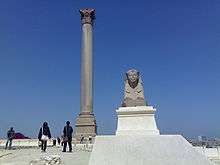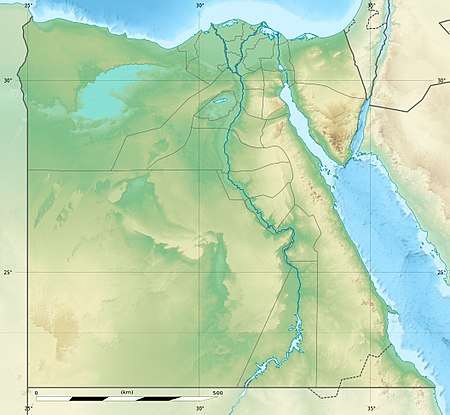Pompey's Pillar (column)
 Pompey's Pillar | |
 Shown within Egypt | |
| Location | Alexandria, Egypt |
|---|---|
| Coordinates | 31°10′56.98″N 29°53′47.23″E / 31.1824944°N 29.8964528°ECoordinates: 31°10′56.98″N 29°53′47.23″E / 31.1824944°N 29.8964528°E |
| Type | Roman triumphal column |
| Width | 2.71 |
| Height | 20.46 |
_1.222_Pompey's_Pillar.jpg)
_-_TIMEA.jpg)
Pompey's Pillar (Arabic: عمود السواري) is a Roman triumphal column in Alexandria, Egypt, the largest of its type constructed outside the imperial capitals of Rome and Constantinople,[1] located at the Serapeum of Alexandria. The only known free-standing column in Roman Egypt which was not composed of drums,[1] it is one of the largest ancient monoliths and one of the largest monolithic columns ever erected.
Construction
The monolithic column shaft measures 20.46 m in height with a diameter of 2.71 m at its base.[2] The weight of the single piece of red Aswan granite is estimated at 285 tonnes.[2] The column is 26.85 m high including its base and capital.[2] Other authors give slightly deviating dimensions.[A 1]
Erroneously dated to the time of Pompey, the Corinthian column was actually built in 297 AD, commemorating the victory of Roman emperor Diocletian over an Alexandrian revolt.[2]
Anecdotes
Muslim traveller Ibn Battuta visited Alexandria in 1326 AD. He describes the pillar and recounts the tale of an archer who shot an arrow tied to a string over the column. This enabled him to pull a rope tied to the string over the pillar and secure it on the other side in order to climb over to the top of the pillar.[3][4]
In early 1803, British commander John Shortland of HMS Pandour flew a kite over Pompey's Pillar. This enabled him to get ropes over it, and then a rope ladder. On February 2, he and John White, Pandour's Master, climbed it. When they got to the top they displayed the Union Jack, drank a toast to King George III, and gave three cheers. Four days later they climbed the pillar again, erected a staff, fixed a weather vane, ate a beef steak, and again toasted the king.[5]
See also
- List of ancient architectural records
- Browne-Clayton Monument
- Pompey's Pillar (disambiguation), listing other things named for this pillar
Notes
References
Sources
- Adam, Jean-Pierre (1977): "À propos du trilithon de Baalbek: Le transport et la mise en oeuvre des mégalithes", Syria, Vol. 54, No. 1/2, pp. 31–63 (50f.)
- Thiel, Wolfgang (2006): "Die 'Pompeius-Säule' in Alexandria und die Viersäulenmonumente Ägyptens. Überlegungen zur tetrarchischen Repräsentationskultur in Nordafrika", in: Boschung, Dietrich; Eck, Werner: Die Tetrarchie. Ein neues Regierungssystem und seine mediale Präsentation, Wiesbaden: Reichert Verlag, ISBN 978-3-89500-510-7, pp. 249–322
| Wikimedia Commons has media related to Pompey's Pillar. |